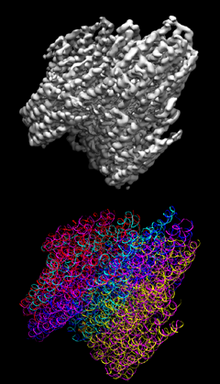DNA origami

DNA origami is the nanoscale folding of
DNA origami was the cover story of Nature on March 16, 2006.[3] Since then, DNA origami has progressed past an art form and has found a number of applications from drug delivery systems to uses as circuitry in plasmonic devices; however, most commercial applications remain in a concept or testing phase.[4]
Overview
The idea of using DNA as a construction material was first introduced in the early 1980s by
To produce a desired shape, images are drawn with a

Bottom-up self-assembly methods are considered promising alternatives that offer cheap, parallel synthesis of nanostructures under relatively mild conditions.
Since the creation of this method, software was developed to assist the process using CAD software. This allows researchers to use a computer to determine the way to create the correct staples needed to form a certain shape. One such software called caDNAno is an open source software for creating such structures from DNA. The use of software has not only increased the ease of the process but has also drastically reduced the errors made by manual calculations.[9][5]
Applications
Many potential applications have been suggested in literature, including enzyme immobilization, drug delivery systems, and nanotechnological self-assembly of materials. Though DNA is not the natural choice for building active structures for nanorobotic applications, due to its lack of structural and catalytic versatility, several papers have examined the possibility of molecular walkers on origami and switches for algorithmic computing.[8][10] The following paragraphs list some of the reported applications conducted in the laboratories with clinical potential.
Researchers at the Harvard University Wyss Institute reported the self-assembling and self-destructing drug delivery vessels using the DNA origami in the lab tests. The DNA nanorobot they created is an open DNA tube with a hinge on one side which can be clasped shut. The drug filled DNA tube is held shut by a DNA aptamer, configured to identify and seek certain diseased related protein. Once the origami nanobots get to the infected cells, the aptamers break apart and release the drug. The first disease model the researchers used was leukemia and lymphoma.[11]
Researchers in the National Center for Nanoscience and Technology in Beijing and Arizona State University reported a DNA origami delivery vehicle for Doxorubicin, a well-known anti-cancer drug. The drug was non-covalently attached to DNA origami nanostructures through intercalation and a high drug load was achieved. The DNA-Doxorubicin complex was taken up by human breast adenocarcinoma cancer cells (MCF-7) via cellular internalization with much higher efficiency than doxorubicin in free form. The enhancement of cell killing activity was observed not only in regular MCF-7, more importantly, also in doxorubicin-resistant cells. The scientists theorized that the doxorubicin-loaded DNA origami inhibits lysosomal acidification, resulting in cellular redistribution of the drug to action sites, thus increasing the cytotoxicity against the tumor cells.[12][13]
In a study conducted by a group of scientists from
Nanorobots made of DNA origami demonstrated computing capacities and completed pre-programmed task inside the living organism was reported by a team of bioengineers at Wyss Institute at Harvard University and Institute of Nanotechnology and Advanced Materials at
DNA is folded into an octahedron and coated with a single bilayer of phospholipid, mimicking the envelope of a virus particle. The DNA nanoparticles, each at about the size of a virion, are able to remain in circulation for hours after injected into mice. It also elicits much lower immune response than the uncoated particles. It presents a potential use in drug delivery, reported by researchers in Wyss Institute at Harvard University.[17][18]
Similar approaches
The idea of using protein design to accomplish the same goals as DNA origami has surfaced as well. Researchers at the National Institute of Chemistry in Slovenia are working on using rational design of protein folding to create structures much like those seen with DNA origami. The main focus of current research in protein folding design is in the drug delivery field, using antibodies attached to proteins as a way to create a targeted vehicle.[19][20]
See also
References
- PMID 23169645.
- PMID 22837684.
- S2CID 4316391.
- PMID 20220817.
- ^ PMID 6188926.
- ^ S2CID 4316391.
- PMID 19458720.
- ^ PMID 16832805.
- PMID 19531737.
- ^ DNA 'organises itself' on silicon,BBC News, August 17, 2009
- ^ Garde, Damian (May 15, 2012). "DNA origami could allow for 'autonomous' delivery". fiercedrugdelivery.com. Archived from the original on September 24, 2015. Retrieved May 25, 2012.
- ^ "Folded DNA becomes Trojan horse to attack cancer". New Scientist. 18 August 2012. Retrieved 22 August 2012.
- PMID 22803823.
- PMID 23030709.
- . Retrieved 9 June 2014.
- PMID 24705510.
- ^ Gibney, Michael (23 April 2014). "DNA nanocages that act like viruses bypass the immune system to deliver drugs". fiercedrugdelivery.com. Archived from the original on 20 September 2015. Retrieved 19 June 2014.
- PMID 24694301.
- S2CID 87992174.
- PMID 22837684.
Further reading
- Kube, Massimo; Kohler, Fabian; Feigl, Elija; Nagel-Yüksel, Baki; Willner, Elena M.; Funke, Jonas J.; Gerling, Thomas; Stömmer, Pierre; Honemann, Maximilian N.; Martin, Thomas G.; Scheres, Sjors H. W.; Dietz, Hendrik (December 2020). "Revealing the structures of megadalton-scale DNA complexes with nucleotide resolution". Nature Communications. 11 (1): 6229. PMID 33277481.
